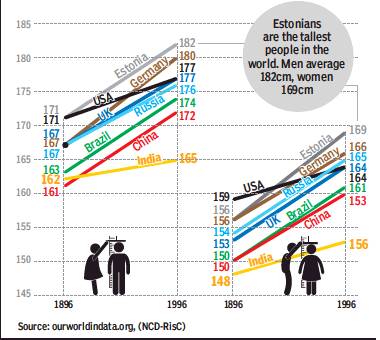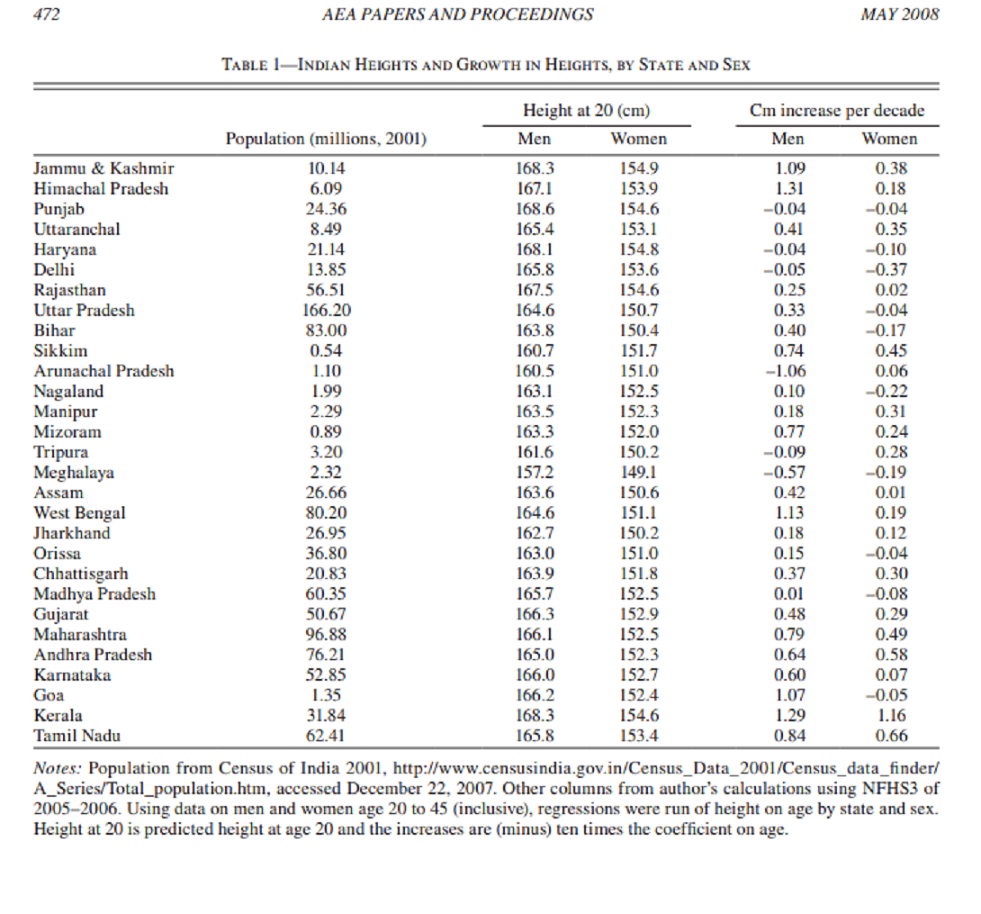Anatomical measurements/ Body proportions: South Asia
This is a collection of articles archived for the excellence of their content. |
Contents
|
BMI
1896-1996: modest improvement of height
See graphic:
The average height of men and women in 1896 and 1996, in centimetres, in India and China, as well as Estonia, Germany, USA, UK, Russia and Brazil
As in 2019

From: Malathy Iyer, Indian teens rank low on BMI, among the shortest: Study, November 8, 2020: The Times of India
While authorities claim Indian children are not as malnourished or stunted as they used to be until a decade ago, a global analysis of data spanning 34 years from 200 countries ranked India at the 196th place with respect to BMI (body mass index). The normal BMI ranges between 20 and 25.
The country’s 19-year-old boys and girls have a BMI of 20.1 compared with, say, China that ranks 88th with its boys having a BMI of 23 and 119th for its girls at 22.2.
As BMI is a function of height, the corollary is that Indian teens are also among the shortest in the world. The review, published in the international medical journal ‘The Lancet’, said India’s boys ranked 180th with an average height of 5.46 feet while girls ranked 182th with an average height of 5.06 feet.
China performed better with regards to height as well. Its 19-year-old boys today were 8cm taller than they were in 1985, with their global rank changing from 150th tallest in 1985 to 65th in 2019. China’s 19-year-olds, on an average, are 5.76-foot tall; Chinese girls were 54th on the global chart, with an average height of 5.35 feet.
“Poor nutrition in school years may have created a 20cm height gap across nations,” said the analysis led by Imperial College London. This 20cm difference between 19-yearolds in the tallest and shortest nations represented an eightyear growth gap for girls and a six-year growth gap for boys, said the study’s authors.
“For instance, the study revealed that the average 19-year-old girl in Bangladesh and Guatemala (the nations with the world’s shortest girls) is the same height as an average 11-year-old girl in the Netherlands, the nation with the tallest boys and girls,” said the authors in a statement .
They listed highly variable childhood nutrition, especially a lack of quality food, as the reason for stunted growth and for a rise in childhood obesity, affecting a child's health and wellbeing for their entire life.
Experts in India blamed malnutrition caused either due to a liking for nutritionally-deficient fast foods in urban areas or due to poverty in rural India. “There is a great disparity in height and weight in various regions of India, the biggest denominators being urban and rural habitat and socio economic statum,” said Delhi-based endocrinologist Dr Anoop Misra.
He said rural children in India had poor nutrition because of low protein and essential micronutrient intake, while urban children hailing from upper socio-economic strata have excess carbohydrates and saturated fats. “The former have low BMI and insufficient height, and latter have better height and BMI and many of them are obese,” added Dr Misra.
Brain size
IIIT, Hyderabad/ 2019
Nirupa Vatyam, Oct 29, 2019: The Times of India
Indians have smaller brains, reveals study
Researchers at the International Institute of Information Technology, Hyderabad (IIIT-H) have created the first-ever Indian Brain Atlas. The study has revealed that the Indian brain, on an average, is smaller in height, width and volume when compared to Western and other eastern populations. This will help in early diagnosis of Alzheimer’s and other brain-related ailments. The research has been published in Neurology India, a peer-reviewed journal.
Jayanthi Sivaswamy of the Centre for Visual Information Technology, who worked on the project, said that the Montreal Neurological Institute (MNI) template, which is used as the standard, was created using Caucasian brains. This, according to the researchers, is not ideal to analyse brain differences in the Indian population. “As Indian brains are smaller in size when compared to MNI, the difference in scans can look alarming and lead to misdiagnosis,” Jayanthi told TOI. She added that MRI images are compared with pre-loaded MNI template to arrive at a diagnosis. “There is clear evidence based on the study that it is desirable to build a larger atlas as it is important to understand structurally what is normal. This would help catch several brain conditions early on.”
Jayanthi said that even Chinese and Korean brain templates had been constructed, but there was no corresponding template for the India-specific population. She said that the first attempt by the IIIT-H team at creating an India-specific atlas involved 50 individuals, evenly balanced out across genders.
“MRI scans of these subjects’ brains were taken at three different hospitals across three different scanners to rule out variations in scanning machines. Emboldened by the results of the pilot study, we went on to recruit 100 willing participants in the eventual construction of the atlas, referred to as IBA 100,” she added.
Jayanthi said that the atlas was validated against other atlases for various populations. “These differences in height, width, and volume are found even at the structural level, such as in the volume of the hippocampus and so on. But overall, IBA 100 is more comparable with Chinese and Korean atlases than the distant Caucasian one (MNI),” she said.
She added that her team is currently focussing on understanding the aging process. “There are many changes that take place in a brain due to advancing age, with the most typical one being atrophy, shrinking of structures,” She also added that this will help in diagnosing dementia or Alzheimers as they are associated with atrophy of the hippocampus.
Breast size
WorldData.info
Source: WorldData.info
Breast size table begins
|
Rank |
Country
|
Cup |
BMI |
|
1. |
Norway |
C-D |
26.2 |
|
2. |
Luxembourg |
C |
25.7 |
|
3. |
Iceland |
C |
25.6 |
|
4. |
United
States |
C |
29.0 |
|
5. |
United
Kingdom |
C |
27.1 |
|
16. |
Turkey |
B |
28.8 |
|
36. |
Japan |
A-B |
21.9 |
|
41. |
Saudi
Arabia |
A |
29.4 |
|
50. |
Pakistan |
A |
24.7 |
|
51. |
Afghanistan |
A |
24.0 |
|
53. |
India |
A |
21.9 |
|
61. |
China |
AA-A |
23.5 |
|
66. |
Israel |
AA |
27.1 |
|
68. |
Malaysia |
AA |
26.1 |
|
71. |
Thailand |
AA |
25.0 |
|
73. |
Indonesia |
AA |
23.7 |
|
74. |
Sri
Lanka |
AA |
23.7 |
|
76. |
Philippines |
AA |
23.5 |
|
78. |
Nepal |
AA |
22.3 |
|
79. |
Cambodia |
AA |
22.2 |
|
80. |
Bangladesh |
AA |
21.8 |
|
81. |
Vietnam |
AA |
21.7 |
Breast size table ends
Height
Acknowledgement
The information about Height in this section has been taken from the article
A century of trends in adult human height: NCD Risk Factor Collaboration (NCD-RisC) Published: July 26, 2016. Study author– Prof Majid Ezzati. Other authors: James Bentham et al, mostly of the Imperial College London, United Kingdom.
Cite as eLife 2016;5:e13410.
Height in adulthood for the 1896 and 1996 birth cohorts for men
|
Country |
1896 |
1996 |
|
Afghanistan |
127 |
175 |
|
Bangladesh |
169 |
185 |
|
Bhutan |
124 |
174 |
|
China |
130 |
93 |
|
India |
101 |
178 |
|
Maldives |
188 |
142 |
|
Myanmar |
178 |
181 |
|
Nepal |
177 |
195 |
|
Pakistan |
47 (yes, 047) |
153 |
|
Sri Lanka |
183 |
170 |
|
Tibet/ No data |
|
|
Height in adulthood for the 1896 and 1996 birth cohorts for women
|
Country |
1896 |
1996 |
|
Afghanistan |
151 |
168 |
|
Bangladesh |
197 |
198 |
|
Bhutan |
171 |
187 |
|
China |
134 |
87 |
|
India |
163 |
192 |
|
Maldives |
189 |
169 |
|
Myanmar |
178 |
177 |
|
Nepal |
187 |
197 |
|
Pakistan |
116 |
185 |
|
Sri Lanka |
179 |
172 |
|
Tibet/ No data |
|
|
What is a cohort?
A cohort
is a group of people with a shared characteristic; and
is a group of people used in a study who have something (such as age or social class--in this case, height) in common.
Explanation
The column '1896' indicates the rank of the country's people in the matter of their Average Height in the year 1896.
The column '1996' indicates the rank of the country's people in the matter of their Average Height in the year 1996.
200 countries were surveyed.
The entire original article can be read at E Life Sciences, from which the two tables given above have been extracted manually. Omissions, if any, may please be sent as messages to the Facebook community, Indpaedia.com. All information used will be gratefully acknowledged in your name.
The average height of Indians and others
2004
The Times of India, Aug 14, 2016
Subodh Varma
Indians growing taller, but fall short in world order
The average Indian is taller than his/her parents, but that's not saying much. Between 1914 and 2014, the average height of Indian men increased by about 3cm to reach 165cm (5'5") while women grew taller by 5cm to become 153cm (5'1"). This leaves our men about 17.5cm shorter than the world's tallest males in the Netherlands, while Latvian women, the world's tallest, tower above our women by 17cm.
These findings emerge from a massive study of human height measurements involving 1,470 earlier studies covering over 18.6 million participants in 200 countries. The study was conducted by more than 800 researchers and led by scientists from Imperial College, London. Most countries have shown an increase in height over the past century, with Iranian men and South Korean women shooting up most-by 16.5cm and 20.2cm. But the once-tall Americans-placed third among men and fourth among women in 1914-slipped to 37th and 42nd place in 2014. Overall, the ten tallest nations in 2014 were dominated by European countries, and featured no English-speaking nation.
Why have some nations shot up while others have not? Environmental factors are important in determining average heights of populations, James Bentham of Imperial College told.
"Factors such as good nutrition, clean water supply, avoidance of childhood infections, and a mother's health during pregnancy affect how much these children grow. We believe that the relatively small gains in height in India are likely to be due to some or all of these factors," he said.
In India, the nutrition board under National Institute of Nutrition (NIN) measured the height of Indian rural men and women at regular intervals between 1975-79 and 2011-12. There was a marginal increase of 1.2cm among men and only 1cm among women, study co-author Dr A Laxmaiah of NIN told TOI. The heights of earlier years were estimated from these records.
Although low height gains in India reflect poor nutritional levels and high disease prevalence, children today are much taller than their parents were at the same age. This has been revealed in studies by Harshpal Singh Sachdev, senior pediatrician at Sitaram Bhartia Institute, comparing children with their parents. "Our data shows that children aged between 5 and 13 years are on average 5.5cm to 7.5cm taller than their parents at the same age 30 years ago. Obviously, they are still in a growing phase and the difference will increase. These changes are comparable to or greater than those seen in developed countries at a similar stage of socio-economic development about 50 years ago," he said.
How much role does heredity play? Sachdev says that there are 200 genes associated with height but their net contribution in determining adult height is about 10%. "Though genetic factors play an important role in determining height at individual level, environmental factors such as income, age-specific balanced diet, sanitation, health facilities may exploit genetic potential," said Laxmaiah. Confirming this, Bentham said that if all populations across the world lived in the same environment, it's likely there would be some differences in mean height between certain populations, but we would not see the 20-23cm gap between the tallest and shortest countries witnessed at present.
The average height of Indians, state-wise
2001
See graphic ‘The average height of Indians, state-wise, in 2001’
Bangladesh: 1886-1986

Shortest in height, by ranking, Bangladesh and the world
Fastest height gain: 1886-1986
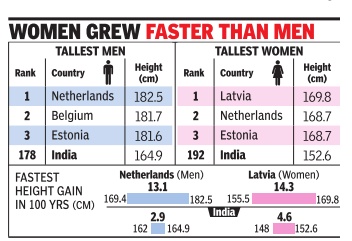
Fastest height gain, men and women, India and the world
2005>16: a decline
Rema Nagarajan, Sep 28, 2021: The Times of India

From: Rema Nagarajan, Sep 28, 2021: The Times of India
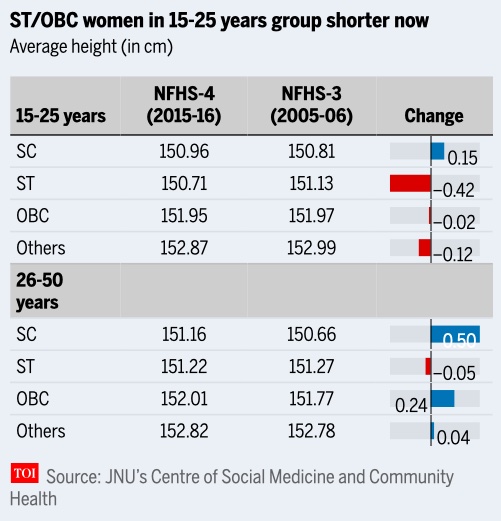
From: Rema Nagarajan, Sep 28, 2021: The Times of India

From: Rema Nagarajan, Sep 28, 2021: The Times of India
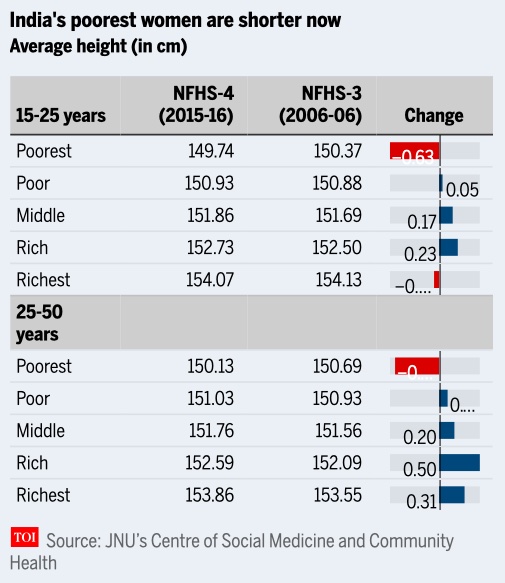
From: Rema Nagarajan, Sep 28, 2021: The Times of India

From: Rema Nagarajan, Sep 28, 2021: The Times of India
In the context of an increase in average heights worldwide, there was, alarmingly, a decline in the average height of adult men and women in India in the decade from 2005-06 to 2015-16 after a significant increase from 1998-99. Women from the poorest sections showed the steepest decline as did tribal women.
The same period saw the average height of women in the wealthier sections improve significantly, showing how closely average height is linked to nutrition and other social and environmental factors. This was revealed in a study published in the open access science journal, PLOS One, that compared the average height of adult women and men from the national family health surveys (NFHS) done in 1998-99, 2005-06 and 2015-16.
A study by Jawaharlal Nehru University’s Centre of Social Medicine and Community Health showed that between 1998-99 and 2005-06, there was improvement in the average height of women in both the age groups analysed irrespective of caste, religion and state, except in Meghalaya, which saw a decline.
For the decade leading up till 2015-16, the 26-50 year age group, unlike the 15-25 group, saw women’s average heights improve marginally except among scheduled tribes (ST) and among the poorest. “Interestingly, women in the age group of 15 to 25 years in NFHS-4 (2015-16), whose height declined compared to the same age group of women from NFHS-3 (2005-06), come from the post-90s birth cohorts, the period when neoliberal policies gained momentum in India,” noted the study.
“Researchers analysed NFHS-3 data to show that an average five-year-old ST girl is 2 cm shorter than an average general caste girl. They further found the differences in socioeconomic status to be responsible for the entire gap in height between ST and general caste children,” stated the study. However, among men, the greatest decline in height was seen among tribal men, the general category and surprisingly among the richest section, even as there was a general decline in the average height of men between 2005-06 and 2015-16.
“Since this is a trend, it cannot be explained away by genetic factors. The same sub-populations are being studied and the secular trends are found to be negative. That is very significant. It should also be seen in light of the overall stagnation in nutritional indicators seen in NFHS-5 done in 2019-20. It is very likely that it reflects not only food insecurity but an overall problem with equitable socio-economic development, or rather a failure to correct historical marginalisation compounded by an actual deterioration in development status brought about by economic factors as well as perhaps newer social marginalisations,” said Dr Vandana Prasad, of the organisation Public Health Resource Network, which works on nutrition and public health issues.
Penis size
Daily Mirror’s report, 2016…
Zahra Mulroy, Daily Mirror, UK, 19 Aug 2016
The world 'penis size' map has been invented and it shows how the average manhood measures up
It's often said size doesn't matter, but it clearly did enough for someone to make this interactive map
And in case you lie awake at night, tormenting yourself wondering about global penis sizes, then rest easy. Someone has come up with a map of the world with such a twist.
Target Map World map shows how your manhood measures up compared to other countries
Yes, Target Map "have created the colour-coded graphic which shows the different sizes of men’s manhood depending on where they’re from" reports the Sun.
The best bit? It's interactive. Meaning you can swoop in, compare sizes and judge to your heart's content.
So how do the world's (approx) 3,400,000,000 adult males measure up against one another?
Well, the competition is stiff.
[Mirror's Nicola Oakley asked] Why do classical statues of men always have small penises? There's an interesting explanation... [Indpaedia’s explanation: Classical statues show flaccid and not erect penises because it would be indecorous to show erect penises--and because at 12.18 cm/ 4.8 in. and 12.5cm / 4.9 in. respectively the Greeks and Romans are not very big guys anyway.]
African, South American and Caribbean nations dominate the top ten with the men down under in Australia not far behind.
As with all things comparative sadly, someone has to come last and that's taken by Thailand, Singapore and North Korea.
Bottom 10 countries
Average erect penis size in inches
Thailand 3.7
Nepal 3.7
North Korea 3.8
Cambodia 4
Sri Lanka 4.3
South Korea 4.3
Pakistan 4.4
Hong Kong 4.4
Bangladesh 4.4
Singapore 4.5
… was cited incorrectly in India
…leading to nationwide glumness.
Therefore, Indpaedia first checked Daily Mirror’s report in the original and found that either an Indian newspaper had cited it incorrectly OR the Mirror website had subsequently corrected its earlier report.
Therefore, Indpaedia went to the original source, Target Map, itself, and painstakingly compiled the table below, so that the Indians and Afghans can stand erect in the comity of nations and the Nepalese, Pakistanis and other South Asians are reassured in the knowledge that what you lose on the swings you gain on the roundabouts.
Indpaedia readers are encouraged to visit these two sites, and additional information gained from them may please be sent as messages (not Timeline posts) to the Facebook community, Indpaedia.com. All information used will be gratefully acknowledged in your name.
The actual South Asian sizes in 2016
|
Country |
Length of erect penis in cm. (SUM) |
Length of erect penis in inches
|
Circumference of erect penis in cm.
|
Circumference of erect penis in inches
|
Volume (n*r^2*L) in |
Source |
|
Afghanistan |
13.69 |
5.4 |
11.42 |
4.5 |
142 |
Journal of Urology |
|
Bangladesh |
11.2 |
4.4 |
10.48 |
4.13 |
97.9 |
Lynn et al 2012 |
|
Bhutan/ No data |
|
|
|
|
|
|
|
China |
12.9 |
5.1 |
11.14 |
4.39 |
127.4 |
Chen XB, Li RX |
|
India |
13.01 |
5.1 |
11.46 |
4.51 |
136 |
K.Promodum et al |
|
Maldives/ No data |
|
|
|
|
|
|
|
Myanmar/ No data |
|
|
|
|
|
|
|
Nepal |
9.3 |
3.7 |
11.87 |
4.67 |
104.3 |
Genital Size Survey |
|
Pakistan |
11.05 |
4.4 |
11.75 |
4.63 |
121.4 |
Genital Size Survey |
|
Sri Lanka |
10.89 |
4.3 |
10.99 |
4.33 |
104.7 |
Genital Size Survey |
|
Tibet/ No data |
|
|
|
|
|
|
WorldData.info’s Analysis of 40 studies
From WorldData.info
It is often claimed that the length of the male limb can be determined by the size of the shoe or the length of the index finger. In three of the more than 40 studies evaluated here, no connection to the length of the index finger was determined. …
The parallel to shoe size, which is so often assumed in the vernacular, is equally unclear. No connection was found here either.
Table on penis size begins
|
Rank |
Country |
Erect
length |
Body
size |
Percentage
of height |
|
1. |
Ecuador |
17.61
cm |
1.67
m |
10.54
% |
|
2. |
Cameroon |
16.67
cm |
1.71
m |
9.75
% |
|
3. |
Bolivia |
16.51
cm |
1.68
m |
9.84
% |
|
57. |
India |
13.71
cm |
1.66
m |
8.28
% |
|
58. |
Afghanistan |
13.69
cm |
1.68
m |
8.16
% |
|
59. |
Israel |
13.60
cm |
1.76
m |
7.75
% |
|
60. |
United
States of America |
13.58
cm |
1.77
m |
7.68
% |
|
61. |
Japan |
13.56
cm |
1.72
m |
7.90
% |
|
62. |
Turkmenistan |
13.48
cm |
1.73
m |
7.78
% |
|
64. |
Greece |
13.30
cm |
1.79
m |
7.44
% |
|
65. |
Russia |
13.21
cm |
1.76
m |
7.50
% |
|
68. |
United
Kingdom |
13.13
cm |
1.78
m |
7.38
% |
|
69. |
China |
13.07
cm |
1.75
m |
7.49
% |
|
70. |
Turkey |
12.99
cm |
1.76
m |
7.39
% |
|
76. |
Pakistan |
12.20
cm |
1.67
m |
7.32
% |
|
77. |
Iran |
11.95
cm |
1.75
m |
6.84
% |
|
83. |
Bangladesh |
11.20
cm |
1.65
m |
6.81
% |
|
84. |
Hong
Kong |
11.19
cm |
1.74
m |
6.42
% |
|
85. |
Sri
Lanka |
10.89
cm |
1.67
m |
6.50
% |
|
86. |
Philippines |
10.85
cm |
1.65
m |
6.59
% |
|
87. |
Myanmar |
10.70
cm |
1.66
m |
6.45
% |
|
88. |
Cambodia |
10.04
cm |
1.65
m |
6.09
% |
End of WorldData.info table on penis size
Waist-to-hip ratio
India: 2019-20
Malathy Iyer, December 15, 2020: The Times of India
In a measure of how unhealthy women in the child-bearing age are in Mumbai, the latest National Family Health Survey of India found that more than half of them have a waist-tohip ratio that is linked to higher risk for non-communicable diseases such as diabetes and hypertension.
The NFHS-5 found 54.5% women in the 15-49 age group in Mumbai city and 58.3% in Mumbai suburban have a waist-to-hip ratio of over 0.85, which is the ideal ratio according to the World Health Organisation In Maharashtra, 44.5% of the women and 40.7% of the men in the 15-49 age group have higher ratio. A closer look at Maharashtra’s statistics, though, show that the ratio is worse in urban areas (51.5% women and 43.2% men) than in rural areas (38.6% women and 38.7% men).
J&K seemed to have the worst proportion (89.2% women and 66% men), followed by Bengal (80.1% and 60.5%) and Kerala (70.1 and 57.2% men). While 51.1% of Goa’s women in the 15-19 age group had higher-than-ideal ratio, only 34.2% of its men fell in the unhealthy category.
These are the first phase of the NFHS-5 (conducted in 2019-20) released by the union health ministry last week, covering 22 states and union territories. Waist-to-hip ratio is important because it measures the fat around the abdomen and an early indicator of a slew of chronic lifestyle diseases. Delhi-based endocrinologist Dr Anoop Misra said a waist-to-hip ratio of over .8 for women and .9 for men is indicative of cardiometabolic problems. Cardiometabolic syndrome — now recognised as a disease by the WHO — is a combination of dysfunctions characterised by insulin resistance, impaired glucose tolerance, dyslipidemia, hypertension, and central adiposity. These dysfunctions lead to diabetes, hypertension and heart problems. Moreover, international studies have shown that certain ethnic groups such as Indians and African-Americans have high-risk waist-tohip ratio. Endocrinologist Dr Shashank Joshi blamed increased gadgetisation and westernation for the fact that half of the men and women in the productive age group had higher WHR. Dr Misra said the abdominal fat deposit can’t be reduced with regular exercise and dieting. “It has been established that Indians need to do take extra measures to reduce abdominal fat,’’ he added.
